When I take visitors around the outdoor aircraft on display at the Pima Air & Space Museum, I always say a few words about these Republic F-84s, early jet fighters that show the evolution from straight to swept wings:
The aircraft with the barber-striped tail is an F-84C Thunderjet, first flown in 1946 and later employed as a strike fighter in the Korean War. As with other early US jets, it was designed with straight wings. The closer aircraft, wearing the colors of the USAF Thunderbirds, is an F-84F Thunderstreak, a swept-wing redesign of the Thunderjet, first flown in 1950.
The museum has another example of the transition from straight to swept wings, namely a pair of pre- and post-Korean War Grumman F9Fs:
|
|
|
The straight-wing F9F Panther, left, first flew in 1947. The US Navy began flying it in 1948; like the USAF’s F-84 Thunderjet, it was a strike fighter extensively used during the Korean War. The F9F Cougar, right, an evolutionary design with swept wings, began replacing the Panther in 1952, shortly before the end of the Korean War.
Swept wings have appeared throughout the history of aviation, but it was the Germans who first researched the application of swept wings to high speed flight, starting in the 1930s and continuing through the war years of the 1940s.

Allied forces encountered the swept-wing Messerschmitt Me 163 Komet (left) and the Me-262 Swallow in combat during WWII. Additionally, German research and designs found their way into Allied hands, and after the war so did a number of German aeronautical engineers and scientists. Leading the charge to introduce swept-wing jet aircraft in the post-WWII years, then, were the British, the Russians, and the Americans.
Britain was the first Allied nation to fly a swept-wing jet: Geoffrey de Havilland’s experimental DH 108 Swallow of 1946. The first British jet fighters, developed during WWII, were straight-wing aircraft like the Gloster Meteor and the deHavilland Vampire. The first operational British swept-wing fighters, the Supermarine Swift and the Hawker Hunter, didn’t enter service until 1954, long after the Russians and Americans had fielded swept-wing fighters.
|
|
|
|
The USSR’s first jet fighter, first flown in 1946, was the straight-wing MiG-9. A follow-on design, the legendary MiG-15, first flew in 1947 and later became the world’s first combat swept-wing jet fighter when it was introduced into the Korean War in 1950.
|
|
|
I think I can safely say it was only in America that earlier generations of straight-wing aircraft were redesigned with swept wings. The Republic F-84 and Grumman F9F aren’t the only examples: the first was the North American FJ-1 Fury, a carrier-based jet fighter for the US Navy, first flown in 1946. The straight-winged FJ-1 Fury was the basis for the USAF’s swept-wing F-86 Sabrejet, first flown in 1947. The F-86 Saberjet in turn was “navalized,” becoming the FJ-2 Fury, first flown in 1951.
Another early jet project, one that went from a straight-wing concept on paper to a swept-wing design in production, was a bomber, the Boeing B-47 Stratojet. Initially designed in 1943 to compete for a US Army Air Force jet bomber contract, it began life as Boeing Models 424 and 432. Upon learning of German wartime developments and seeing early wind tunnel data from Langley, the chief of Boeing’s technical staff, George S Schairer, sent his designers back to the drawing board with orders to develop a swept-wing bomber. The design evolved into the conceptual Models 448 & 450, and eventually into the actual swept-wing, six-engined XB-47, which first flew on 17 December 1947.*
|
|
|
When it came to breakthroughs in aircraft design, the 1940s and early 1950s were heady days. The Germans, of course, get credit for understanding the usefulness of wing sweep in transonic and supersonic flight, though they built few practical examples, and, despite rumors, probably never achieved supersonic flight. I’m not sure how to score the rocket-powered Me-163; it did see combat in the waning days of WWII, but of course it was not a jet, and apart from takeoff and climb, it was actually a very fast glider. The Allied countries of WWII benefitted greatly from the groundwork laid by the Germans. The British were quick to experiment with German ideas after WWII, though they didn’t begin fielding swept-wing fighters of their own until the early 1950s. The Russians, clearly, were the first to fly a swept-wing jet fighter, the MiG-15, in combat; the USAF had concurrently developed a swept-wing jet fighter, the F-86 Sabrejet, which quickly gained dominance over North Korea skies when it followed the MiG into combat.
What, exactly, did we gain by replacing straight wings with swept wings on some of our early fighters? The F-84 Thunderjet topped out at 540 knots in level flight; the Thunderstreak at 604. The Panther could achieve 500 knots, the Cougar 620. The FJ-1 Fury maxed out at 475 knots—the F-86/FJ-2 around 590, and it could go supersonic in a shallow dive. All three redesigned aircraft gained in range and ceiling as well. Granted, they got more powerful engines along with their swept wings, but they also gained weight in the process. The aerodynamics of swept wings was a major factor in their higher performance. The Germans were onto something.
*When we think of early swept-wing jets we tend to think of fighters. It’s interesting to note that the F-86 Sabrejet’s first flight, on 1 October 1947, preceded the first flight of the XB-47 Stratojet bomber by just two and a half months, and that the first MiG-15 didn’t fly until 30 December 1947, two weeks after the XB-47 (and two months after the F-86).
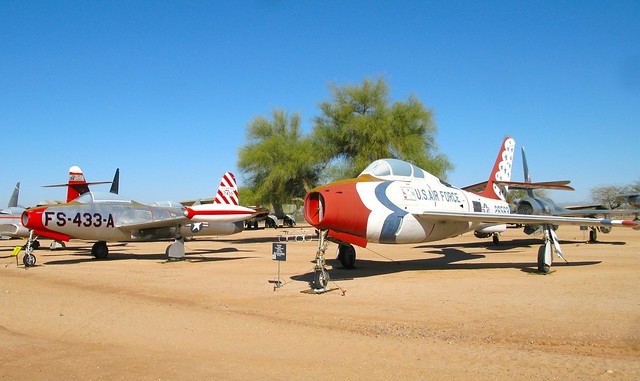
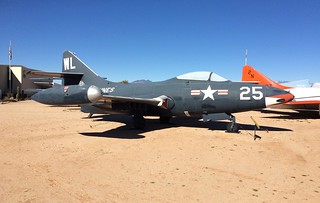
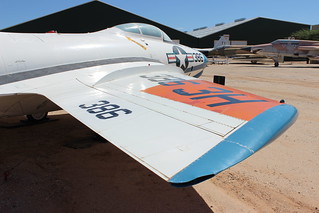
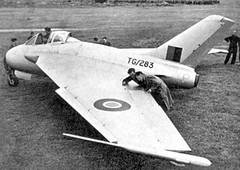
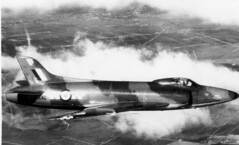
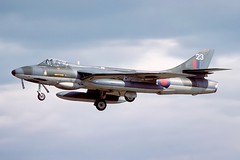
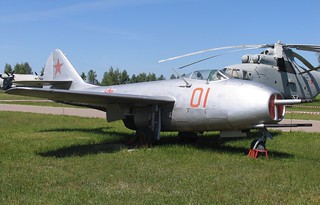
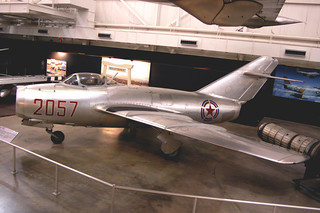
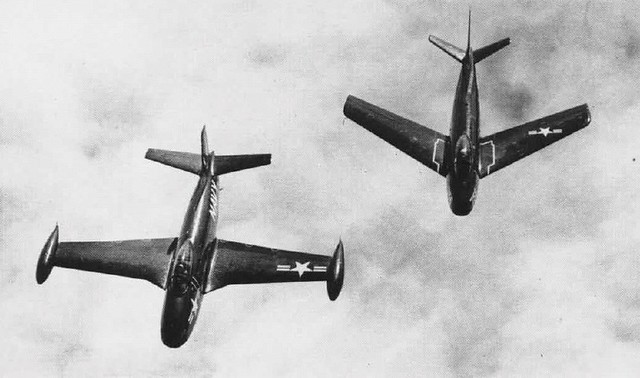
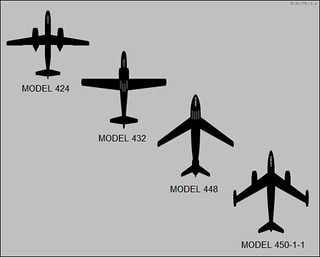
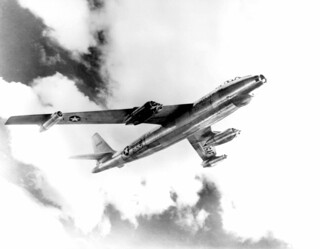
Why do you classify the Me-262 as “non-swept wing” ? It isn’t a big sweep, but it looks swept to me, and the Allies certainly encountered them in combat.
-Kle.
Klebert is quite right: the Me-262 did have slightly swept wings, and I have corrected the post to include it.